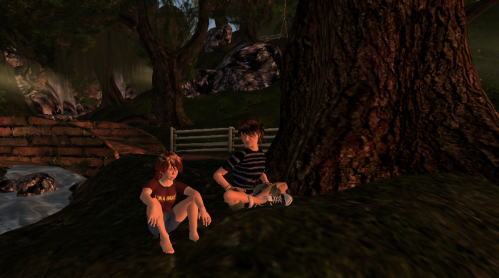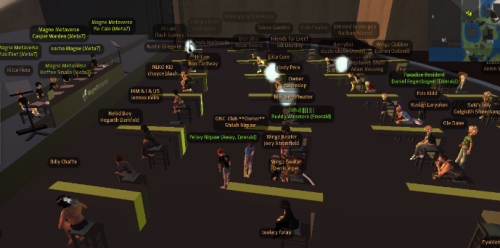
Sacha and Pais doing some thinking while enjoying the copy-protected content at a sim in Second Life
There are many approaches to Content Rights
There are many ways to look at ownership and property. There are diverse philosophies, cultures and systems that have been used in various times, countries, technologies, and economies. What is interesting for citizens of the metaverse like ourselves is we can seen in our worlds several kinds of systems working simultaneously. For instance, in Second Life we can 1) create our own content for our own use, to give away, or to sell; 2) find amazing amounts of free things of all types; or 3) barter, rent, or purchase all manner of land, content, or services. Furthermore, we can experience the SL-type of virtual world through the corporately-run Second Live by Linden Labs, we can privately license it via their project Nebraska stand-alone version, or you can wade into the Opensim opensource version, and maybe roll-your-own version like Meta7. These have elements of different types of economic systems.
Creationalist Capitalism
The nature of the economy that has evolved in Second Life based around user-created comment is no small thing, and may be an indication of larger shifts in our real world economy. This aspect of SL is what Tom Boellstorff called “creationlist capitalism” in his book Coming of Age in Second Life. This summary from The New Atlantis sums it up nicely:
Coming of Age in Second Life suggests that what it has to offer is a third way between the twin perils of modernity: the untrammeled capitalism that alienates man from his labor, and the collectivist solutions to this alienation that crush individual freedom. Drawing heavily on Henri Bergson’s depiction of the Homo faber (man the maker), Boellstorff proclaims that virtual worlds like Second Life are inaugurating a new “Age of Techne” in which the capacity to fabricate will become the defining aspect of humanity. This new age will be rooted in what Boellstorff calls “creationist capitalism … in which labor is understood in terms of creativity, so that production is understood as creation.” Production and consumption will no longer beget alienation, but rather, the creation of new worlds and better selves.
I make these points to describe and underline the importance of the ability to create and sell, because this, in turn, gets us back to Content Rights, and my conversation with Sacha.

Second Life merchants sell things like these wonderful trees and other landscape objects
The reason why I show Sacha and Pais talking under a big, beautiful tree is because we had two kinds of content rights discussions, and one of them involved content from an SL merchant, and both involved Meta7.
Copybot Contraband
Content rights are commonly violated. Music, movies, SL trees – anything that is digital can be copied and pirated. Many debates about this are unresolved. Whole industries, such as for music and movies, invest millions to protect their content rights. In my humble opinion, these particular industries have been extremely slow to adapt to the changes in technology that affect their mediums.
In terms of Meta7 and other similar OpenSim grids, people are able to use things like copybots to pirate copies of Second Life content to the other grids. The motivation to do so is easy to understand – if one is using Meta7, they will likely want some of the cool things they own in SL. Meta7 may now have an economy engine and the ability to exchange L$ and M$, but there is yet to be any intergrid transfer of objects on the horizon. Over time, a lot of content from SL has started showing up in Meta7. Some of this was copy protected in SL. Recently Sacha was contacted by the owner of some of this pirated content – trees from a particular merchant. When Sacha gets these kinds of complaints he needs some evidence that the complaint is founded. In the case of the trees, it was easy to see that their unique content had indeed been copied to Meta7.
From here things could have gotten ugly. Think about the horrible pains we have had to endure when the music and movie industries react to similar problems like the clumsy, greedy, dinosaurs they are. In the case of these particular trees and Meta7, the solution was amicable. First of all, Sacha provided a way to get the SL merchant in business in Meta7, providing a sim for a few months to help them get established as a retailer. In exchange, the merchant is offering amnesty to their existing pirated content – people will be able to pay a reasonable fee to upgrade the tree objects in their landscapes to legal status. I think this sets an excellent precedent to a problem created by changes in some parts of our technology outpacing others.
Opensource versus Licensed Code
Another long running debate in cyberspace that has been echoed in Meta7 is opensource code versus licensed code. We all would like things to be free, but we all want to be able to make a living. One of the wonderful things the web brings us is the ability to crowdsource problems and collaborate on development. Thus, we have opensource project like OpenSim. This was created by many people contributing and collaborating and making it all freely available on the web. This is how K-Grid, and then Meta7, got their start. The MMR programmers worked with OpenSim code. Some of their ideas, creations, and improvements where contributed back to OpenSim, but some are kept exclusively as MMR’s version that they use for Meta7. This is completely legal. MMR is using Meta7 to provide a service – an alternative to Second Life where they can offer innovations to guests and paying customers. The income, of course, is used for the hardware, bandwidth, and support. Why would people want to pay for another type of Second Life? First is the cost, which is an order of magnitude less than the cost of owning sims in SL. The other is the types of innovations that Meta7 has been implementing – for many metaverse residents, this provides more fun than SL, which because of its size and other reasons, has a lot of inertia to overcome to try anything new.
In my opinion, there is no one way to approach content rights. Also, the way we create and exchange things of values will continually change as our technology changes. We need to balance the ability to share, collaborate, and help our creativity and innovation flower, while at the same time allowing people who bring about creativity and innovation have the ability to retain some rights of ownership and, if they desire, financial gain.







